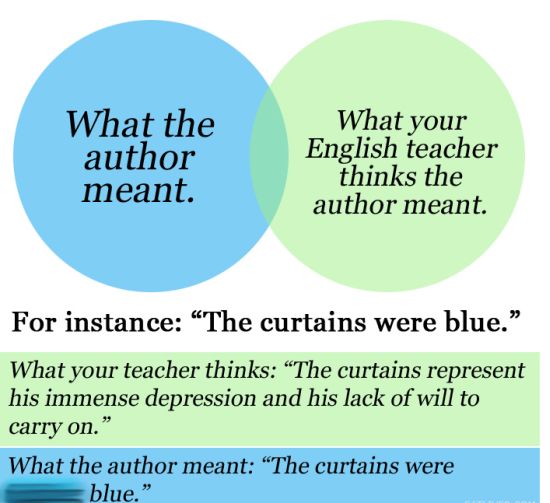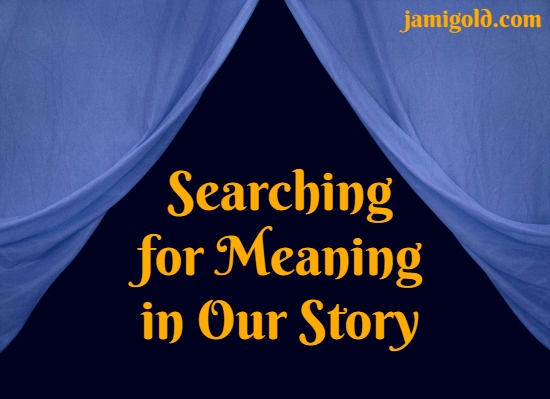A joke about writing, meaning, and interpretation has circulated online for a long time. The idea is that literary analysis often delves far past an author’s intentions into imagining nonexistent meaning, usually in an attempt to establish deeper layers in a piece of writing (and thus justify their reason to analyze).
In the joke, a Venn diagram of two circles—”What the author meant” and “What your English teacher thinks the author meant”—barely overlap. The joke is funny because it rings true for many.
From school assignments to book reviews, we might have encountered those with puffed up, self-important, and/or false analyses of stories. (Or we might have half-tongue-in-cheek tried out those methods ourselves to aim for a better grade. *grin*) The general impression is that level of analysis exists mainly to make those doing the analyzing seem smart rather than having anything to do with the story itself.
With the help of the image that commonly shares the joke, the term blue curtains has become a shorthand reference for that style of analysis:

The joke also brings up the question: What’s a story’s “true” meaning (and who defines it)? Let’s take a look…
How Intentional Are We?
In the advice here on my blog, I often remind writers to write with awareness and intention. It’s easy to write in a halfway “lazy” style, where we just type the first idea or sentence or word that comes to mind.
That drafting style can lead to stories that feel like they’re nothing but clichés and formulaic writing. Descriptions and events will feel predictable or vague because we’re not digging deep enough into our writing craft and brainstorming toolbox to “write fresh” or add evocative details.
In fact, much of editing is about questioning whether we have valid reasons for whatever we wrote or if we need to revise:
“Everything we write should be intentional—the words we use, the events we emphasize, the emotions we evoke, the themes we build, etc. But there are many ways our writing might not match our intentions.”
In other words, we’re allowed to break grammar rules if we meant to do so. If we didn’t mean to, that’s just bad craft.
But We Can Never Be 100% Intentional
However, no matter how much we write with intention and awareness, hidden meanings that we’re not aware of can creep in. Sometimes it’s an unintentional theme, sometimes it’s subtext we didn’t realize was there, and sometimes our biases can shape our stories without us knowing.
Why is it so difficult to ensure readers interpret our story and its meaning the way we want? Click To TweetAs writers, most of us have experienced the power of our subconscious when it comes to brainstorming, or maybe our humming or doodling suddenly reveals a pattern we didn’t intend. That same subconscious can sneak in ideas behind our back.
That risk is a big part of why we need beta readers, editors, and/or sensitivity readers. What we intended isn’t necessarily what made it onto the page, and in the case of sensitivity readers, what’s on the page could be harmful without us realizing it, making a double-check extra valuable.
So there is room to question how much an author is the ultimate authority of the meanings within their story. Unintended meanings can certainly exist beyond what we thought were there. How far can we take that question?
But What Does the Audience Think?
This past week on Twitter, I came across a thread claiming that the movie Ghostbusters is about Christian democracy. Writer J. Michael Straczynski (most well-known in my corner of fandom for the TV show Babylon 5), quoted the thread and disagreed:
While we are all free to interpret stories to our heart’s content…that is the *purpose* of art…to make a declarative statement that the film *is* “about Christian democracy” is a different thing entirely and implies intent. Having worked closely with the film-makers for… https://t.co/hpBQggUMGL
— J. Michael Straczynski (@straczynski) February 24, 2020
A writer for The Real Ghostbusters cartoon, JMS (as he’s known in the fandom) worked with the minds behind the movie. So as he says further down his reply thread, that means he knows for certain that meaning wasn’t intended:
“Granted, intent does not and should not preclude interpretation, but interpretation does not equate causation, and to say of one’s interpretation “this is what this film IS, this is why it was written this way,” is incorrect and grandiose and opens oneself up to…well, to replies like this.”
The original poster came back with an acknowledgment that he didn’t mean to claim that his interpretation was actually the intention:
It was all in good fun, @straczynski. I did not seriously believe that Dan Ackroyd or Harold Ramis intended to apply the principles of Catholic social teaching to their movie. It’s just interesting how these coincidences made their way into the movie. https://t.co/gU9s8mIStI
— James Patterson (@McGillPatterson) February 24, 2020
To which JMS graciously replied and agreed. (Yes, an actual discussion on Twitter that didn’t devolve into yelling and name-calling. *grin*) But the exchange also illustrates how an audience can find meaning beyond the creator’s intention.
Stories Always Contain Some Ambiguity
If we tried to write a story without any ambiguity, without anything open to interpretation, the result would be an overwritten, boring mess. We’d have to spell out every detail in plain language, step-by-step.
Instead of “He approached and whispered in her ear,” we’d have “He wanted to whisper in her ear, so he took the three steps necessary to bring him closer and then leaned his upper body toward her head. Once in position, he expressed his words to her in a quiet volume.”
No metaphors. No figurative language. Only straightforward, deadly dull statements.
Just as English classes and reviewers can overthink the analysis side of the coin—turning reading into a quest to see who can “discover” the most “hidden” meanings—writers can overthink about the risks of misinterpretation. Sometimes it doesn’t matter if the reader comes to their own conclusion.
Focus on the Meanings You Intend
When I was a newbie writer and entering contests for feedback, one contest judge gave me the worst advice. She commented all over my pages with questions like “What color is the carpet of her bedroom? If she sees it, we should see it too.”
Our stories can't avoid ambiguity, so focus on the details that matter. Click To TweetIn other words, she thought it was an author’s job to make sure the movie that played in the reader’s mind as they read exactly matched the movie we imagined as we drafted, right down to carpet—or curtain—colors. (Forgetting, of course, that not everyone even sees “movies” as they imagine.)
Luckily, I quickly realized that feedback was hogwash. We don’t usually think about the color of the carpet in our home—unless there’s something wrong with it to catch our attention. And if we’re writing anywhere close to deep point of view, if the character doesn’t notice it, we wouldn’t make the reader notice it either.
For many aspects of our story, from exactly what our characters look or sound like to the minute details of the setting, it’s okay if readers come away with different ideas. Part of what I’ve learned is to give only enough details to paint a general picture (such as three details of a setting) and then to only focus on the details that matter.
For example, does it matter how a character walks toward another?
- If no, gloss over the details and don’t worry what readers imagine during the action.
- If yes, focus on using the best word to get readers close to the right idea, such as with a verb like saunter, stumble, or lunge.
More often than we might think, the specifics don’t matter for reader understanding. But when we want to create or avoid certain interpretations, that’s when we increase our awareness and level of intention.
What If We Want to Create Deeper Meanings?
We can be the ultimate authority in what we intend for a story, but intention doesn’t always matter. Some stories have deeper meanings that readers will never pick up on, and some stories have no deeper meaning—but readers find allusions and interpretations anyway.
How can we add deeper meanings to our stories when readers misinterpret details so easily? Click To TweetSo we can’t ever 100% guarantee that readers’ perceptions and interpretations will line up with our intentions. Not only might we miss subtextual ideas or whatnot that crop up in unintended ways, but we also can’t control for readers’ experiences and point of view coloring their perceptions of our story (and there’s no right or wrong when it comes to perceptions—they just are).
That risk goes double (or triple) when we attempt to add deeper meanings in our stories, as themes and the like are often left in the subtext and thus more easily misinterpreted or missed entirely. But the same principle as mentioned above applies to however deep we want to embed meanings in our stories—or to however much we want to avoid other meanings, such as the unconscious bias and negative stereotypes our story might reflect. That principle being: How much does the reader’s interpretation matter to us?
For example, if we want to include deeper meanings in our story, we have to ask ourselves if we’re okay with readers missing out on those meanings. Are we okay with any consequences if they think our story is (and maybe judge our story for being) shallower than we intend?
If yes, we can leave our deeper levels in subtext or clues. If no, we might want to spell things out a bit more.
There’s no right or wrong answer with this question. Some authors want readers to know all the meanings so they’ll never have to “go hunting” like in an English literature class. Others get a kick out of treating deeper meanings like Easter eggs for those who read more deeply.
Or for another example, we might receive feedback that our story includes unintended negative stereotypes. We’d usually want to avoid that interpretation—it matters to us to avoid causing harm—so we’d want to look deeply into our story and root out all the details and subtext that create that impression. But even if we’re questioning our biases to get rid of the stereotypes, we might also want to get a sensitivity reader to double check for what we missed, simply due to different life experiences.
Either way, just know that we can’t control readers’ interpretations. But we should listen to feedback when an interpretation goes against what we actively want for our readers’ experience, as there’s usually something we can tweak or clarify to help most readers. *smile*
Have you experienced or seen the “blue curtain” style of overanalysis? What were the circumstances? How much do you worry about reader interpretations? What interpretations matter to you, and which don’t? How much do you try to add deeper meanings in your story, and how do you approach reader interpretation of them?

